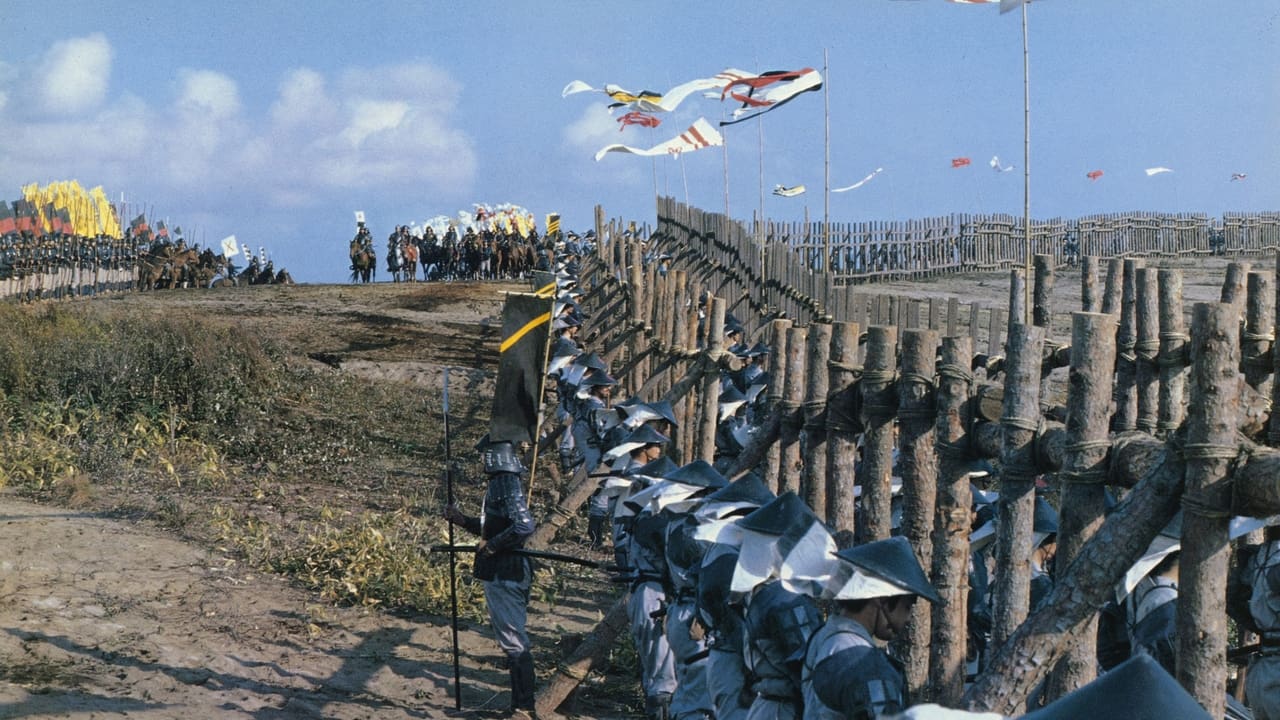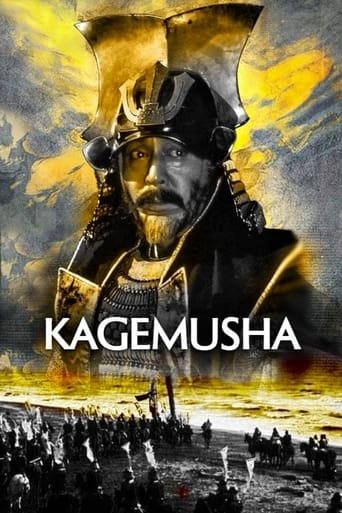

Lack of good storyline.
... View MoreIt’s sentimental, ridiculously long and only occasionally funny
... View MoreThis is a coming of age storyline that you've seen in one form or another for decades. It takes a truly unique voice to make yet another one worth watching.
... View MoreThe movie really just wants to entertain people.
... View MoreWell I watched this movie years ago, it even compelled me to read up on Shingen Takeda and my goodness he was one of the most interesting characters of the Sengoku period! Also he was known for the 'Fu-Rin-Ka-Zan' motto emblazoned on his war banners.This is interesting take on how things went after the death of Shingen and how the Kagemusha was able to impersonate Shingen but the way the story is told is incredible! Tatsuya gives memorable performances as both the real Shingen and the Kagemusha also the actors who play the Takeda generals performances are also nothing to be sneezed at.This is as we can expect from not just a great director like Akira Kurosawa but also him as a descendant of samurai.Definitely recommended for those interested in the Sengoku Jidai (Age of the Country at War) or for fans of samurai films in general.
... View MoreWhile not in my top 5 Kurasawas(Seven Samurai, Ran, Ikiru, Yojimbo, The Hidden Fortress), it is a very impressive film in its own right. The use of colour and the camera work are absolutely wonderful, as is the delicacy and ambition of Kurasawa's direction and the hauntingly beautiful music. The last part of the film seemed rather rushed to me(though the very end is indeed powerful), but the rest of the story is very poignant, stirring stuff with a good mix of simplicity and complexity. The script is almost Shakespearean in quality, the characters are multidimensional with the relationship between the Lord's men and the thief Kagemusha's most fascinating assets and the lead performance of Tatsuya Nakadai is outstanding, as far as I'm concerned one of the finest lead performances of any Kurasawa film that isn't Toshio Mifune. In conclusion, not one of my favourite Kurasawas but still a great film with much to admire. 9/10 Bethany Cox
... View MoreThis one is known by many to be a 'warm-up' to "Ran". Perhaps that should have been a warning, as I wasn't a huge fan of that film. But still, I remained interested in this one and it looked good. But lordy did I find this one a big, beautiful, empty bore. I mean, sure, the visuals are crazy good at times, lovely colors, and it is just in general a great looking movie. Excellent design and all. But at the same time I sort of feel that's all that was to it.The performances here aren't nearly as stilted or obnoxious as some in "Ran", and in fact I really like Tatsuya Nakadai in this. The problem here is that I don't think anyone involved was given much interesting material to work with. It isn't that I don't think there is an interesting story to be told here, but I sort of see this movie as a missed opportunity. Instead of focusing more on developing the character of the impersonator, too much time is spent on scenes of rival sides scheming and questioning if Shingen is alive or dead. Things seem to only be addressed on the surface and the character interactions are never given enough time to breath. More importantly, this might not be as much of a problem if the film didn't move at such an excruciating pace. Some films are deliberately paced a certain way and some films are slow-burning, but this one just feels slow, period, and without much of a purpose most of the time.Additionally, I often found that scenes and drama were laboriously set-up within the story, then those scenes slowly unfolded, and then there is little actual pay-off. Take for instance the section of the story where the one Clan leader decides to send a priest carrying medicine as a supposed "gift" to Shingen, but really they want to find out if Shingen is actually alive or not. This is thoroughly explained by the Clan leader. Then when the priest arrives, Shingen (or the impersonator) and his fellow leaders discuss how they KNOW what the other Clan leader is up to, and how they must hide it! Then when the scene actually HAPPENS there ends up being little to no tension and nothing actually comes of it. It's just completely frustrating to watch! Scenes go on forever and sometimes the film just feels dead. All of a sudden then we'll cut to a scene of rousing music as men on horse-back prepare for battle. It felt like it all had no real flow at all. Even the battle scenes were really disappointing -- the ones at night were very hard to follow.I will admit that the movie can be a stunner at times. That ending is really something, but even then it feels like the film is shouting "LOOK HOW EPIC AND TRAGIC I AM!!!!" Sort of like "Ran", really. But in retrospect, this film makes me appreciate "Ran" even more, for where that movie sort of falls apart for me in its later stages, at least it had a little umpf to it. "Kagemusha" feels like it never actually gets off the ground. Kurosawa is a great filmmaker, but I can't get behind this one.
... View MoreAnother samurai epic by the master of the genre Akira Kurosawa; which, I find to be a mostly fulfilling attempt.The film follows the life of a peasant thief named Kagemusha who happens to look like the warlord of the Takeda clan Shingen. He is found by Shingen's brother Nobukado where he is trained to be Shingen's third body double in case of emergency. Of course this fate is realized when a assassin's sniper rifle finds Lord Shingen during a battle. Shengin remains alive for a while to let his men know that he wanted to be alive three more years for it was his goal to capture Kyoto and if he should die he would want it kept a secret so his clan would not go into disarray. Unfortunately Shingen passes from his wound and it is decided by the his cabinet that Kagemusha must pretend to be Shingen for three years (this secret is even kept from Shingen's family).It is important for his double to keep his persona for if his enemies were to suspect lord Shigen dead then they wouldn't have fear of attacking, but knowing that he may still be living made them second guess their attacks and kept the clan safe. It also helped to protect the clan from itself for the warlords replacement was a mere boy and a son who is blanketed by his father's shadow who is trying desperately to find himself(which is a major theme of the film).Their are many themes in this film of which to talk about but the most important one is finding ones self. Shingen's son Katsuyori is very lost even before his father's death. His son is the next in line to become leader of the clan ,which; brings him much embarrassment for he has felt his father was not fairing of him making him want to distance himself from Shingen's lore. These feelings later in the film become cataclysmic as certain discoveries are made. Kagemusha himself is lost between loyalty to his master and still knowing himself ,which; he is not able to be under the circumstances. There is a point in the film when he takes the persona too far it has dire consequences, but it puts things back in perspective for him where he finds what he truly loves.The first two hours of the film are phenomenal, but the battle sequences once began got a little confusing at times especially a scene at night where you're not sure who the friends or enemies are. I didn't fully understand the sequence until it had ended and I felt it was the weakest part of the film lasting I believe between 15-20 minutes. I wasn't a big fan of the ending also it felt a little rushed to me for Kurosawa ,which; I find to be out of character for him, but I will say the films final shot was magnificent.To Conclude I would say that despite the weak final act the rest of the film was very entertaining with an interesting premise and strong characters. If you are a Kurosawa fan you will love it as I did, however; it is definitely not in the category of Seven Samurai, or Roshomon. Visually astounding(the nightmare sequence was my favorite) at times and maybe a little confusing at others in the end it is to good of a film to pass up on even if it has its flaws.
... View More